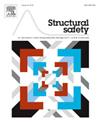A practical framework for determining target reliability indices for the assessment of existing structures based on risk-informed decision-making
IF 6.3
1区 工程技术
Q1 ENGINEERING, CIVIL
引用次数: 0
Abstract
Target reliability levels define structural safety requirements. Most current studies on target reliability indices () have focused on reliability-based design for new structures. However, existing structures face significant safety challenges due to ongoing aging and financial constraints that limit maintenance and reinforcement efforts. Therefore, determining appropriate for the assessment of existing structures is crucial to balance the tradeoff between safety and economy. This study develops a practical, risk-informed framework to streamline the determination of for the reliability assessment of existing structures. It involves six critical steps including context definition, structural system modeling, failure statistics analysis, risk criteria establishment, and selection. The framework’s practical application is carefully demonstrated through a case study centered on the reliability assessment of existing medium- and small-span (MS) bridges in China. A database was compiled for failure statistics of MS bridges, documenting 241 bridge collapse incidents in China spanning from 1983 to 2024. The statistical analysis of lethality ratios and fatalities from these failure events is incorporated into individual risk criteria, group risk criteria, cost optimization, and the marginal lifesaving cost principle. Using these criteria, alongside a refined as low as reasonably practicable (ALARP) principle, informed decisions are made on selecting for reliability differentiation. Finally, three safety levels of are recommended for the bridge system as well as individual components. The proposed methodology framework, as demonstrated in the case study on MS bridges in China, can be readily applicable to the determination of for various other existing civil structures.
基于风险知情决策的既有结构评估目标可靠度指标确定实用框架
目标可靠性水平定义了结构安全要求。目前关于目标可靠度指标(βt)的研究大多集中在基于可靠度的新结构设计上。然而,由于持续老化和财政限制,现有结构面临着重大的安全挑战,限制了维护和加固工作。因此,确定适当的βt用于现有结构的评估是至关重要的,以平衡安全与经济之间的权衡。本研究开发了一个实用的、风险知情的框架,以简化现有结构可靠性评估βt的确定。它包括上下文定义、结构系统建模、失效统计分析、风险准则建立和βt选择六个关键步骤。通过以中国现有中小跨度桥梁可靠性评估为中心的案例研究,详细论证了该框架的实际应用。建立了MS桥梁失效统计数据库,记录了1983年至2024年中国发生的241起桥梁倒塌事件。这些失效事件的致死率和死亡人数的统计分析被纳入个人风险标准、群体风险标准、成本优化和边际救生成本原则。使用这些标准,再加上精炼的尽可能低的合理可行(ALARP)原则,在选择βt进行可靠性区分时做出明智的决定。最后,对桥梁体系和各个部件推荐了三个安全等级的βt。正如在中国MS桥梁案例研究中所展示的那样,所提出的方法框架可以很容易地适用于确定其他各种现有土木结构的βt。
本文章由计算机程序翻译,如有差异,请以英文原文为准。
求助全文
约1分钟内获得全文
求助全文
来源期刊

Structural Safety
工程技术-工程:土木
CiteScore
11.30
自引率
8.60%
发文量
67
审稿时长
53 days
期刊介绍:
Structural Safety is an international journal devoted to integrated risk assessment for a wide range of constructed facilities such as buildings, bridges, earth structures, offshore facilities, dams, lifelines and nuclear structural systems. Its purpose is to foster communication about risk and reliability among technical disciplines involved in design and construction, and to enhance the use of risk management in the constructed environment
 求助内容:
求助内容: 应助结果提醒方式:
应助结果提醒方式:


